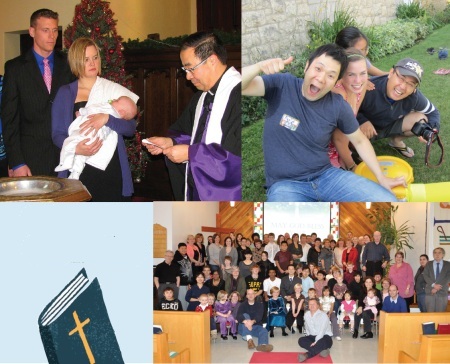Having a non-Caucasian minister makes congregations confront the reality of world Christianity. This challenge enhances the life of the congregation in a number of ways.

Top: Rev. Dr. Dong-Ha Kim baptizes Drew Arthur Edward Kostomacha at First, Brandon, Man.; VBS participants with youth pastor David Chang (left) and Rev. Minho Yoo (far right) at Knox-Zion, Carberry, Man.; Bottom right: Friendship Sunday at St. Andrew’s, Thompson, Man. (Rev. Sean Kim sits in the centre.)
First, it pushes the congregation to think in multi-ethnic terms. One layperson described how having a Korean minister opened her eyes to recognize brothers in Christ among the temporary agricultural workers from Central America in her community. While she knew intellectually the church was strong in Central America, it took a non-Caucasian presence in her church to move that knowledge to a lived awareness of the multi-ethnic nature of the local Christian church.
Second, an immigrant minister has connections with the needs of the church in their birth country and is able to describe opportunities to authentically care for a Christian community far away. The Canadian church with an African minister has a direct conduit to support people in need, developing a relationship with another part of the worldwide Christian community.
Third, congregations with non-Caucasian clergy learn quickly that the Canadian church is bound by its culture. In conversations between lay leaders and non-Caucasian ministers, the lay leaders begin to see there are a variety of ways for a congregation to do what it does. The immigrant clergy have a toolkit of responses to use as pastoral and leadership situations arise, but their toolkit was not put together in Canada. As the ministers use their toolkit, they bring patterns and approaches which are different than the ways ‘we have always done things.’ This discovery is unsettling but it opens the congregations they serve to Christian practices found in other parts of the world.
Non-Caucasian clergy, generally, are deeply committed to evangelism, and are far more willing to use the language of evangelism than their Caucasian counterparts. Over the course of this project, I learned a great deal about the conversion experiences of the ministers involved. I did not ask them for their testimonies; the stories came out naturally in conversations I had with ministers and lay people who recounted their minister’s stories. The natural ways the ministers told their stories provided their parishioners with helpful models for the telling of their own stories. As the language of conversion becomes part of a congregation’s life there is a growing openness to—and even expectation of—conversion as part of the Christian walk. The language of conversion has become muted in many Presbyterian congregations, and the openness of these non-Caucasian ministers to speak of conversion and to expect conversions is noteworthy.
The evangelistic drive can be seen in the variety of outreach ministries undertaken through the leadership of the non-Caucasian clergy. Jonathan Kwon teaches taekwondo not just as a physical outlet for children and young people, but as a means to reach people who would never come to the church. Another member of the Swift Current, Sask., congregation has started an aerobics class with the same purpose. St. Andrew’s, Thompson, Man., held a Friendship Sunday and banquet; the congregants invited their friends, neighbours and co-workers to attend church, doubling the congregation’s size that Sunday. While none of these initiatives are unique, what is significant is that these initiatives took place in congregations where hope had all but died and energy was at a low ebb. That these congregations launched such projects is a testimony to the evangelistic vision and commitment of the first generation immigrant clergy involved.
While this project focused on congregations in smaller communities on the prairies, the missionary rebound is not limited to those communities. A number of rural and small town congregations in southern Ontario have recently called first generation immigrant clergy. All indications are the missionary rebound is here to stay. While the impact of the rebound has yet to be fully seen, it will change the face of the church. If the rebound is bringing hope and energy to a number of congregations, might the rebound bring renewed hope and energy to the Presbyterian Church in Canada as a whole?

